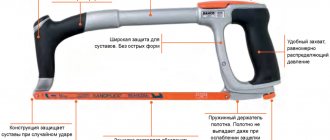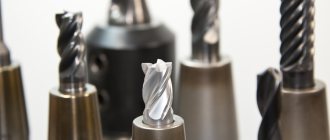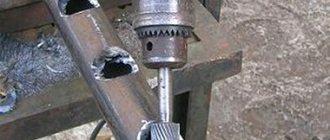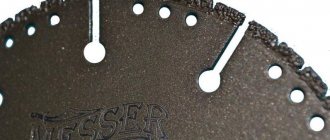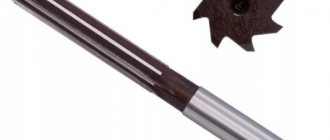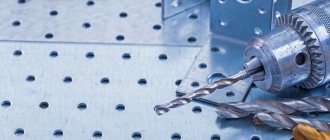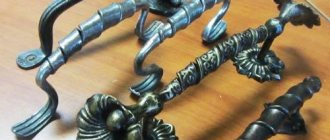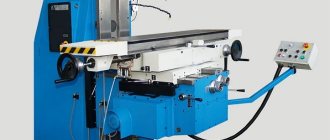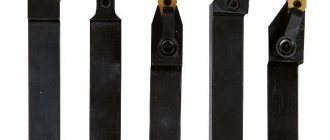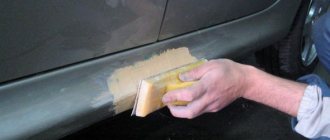A hacksaw for metal consists of a machine (frame) to which a hacksaw (saw) blade is attached. Cutting (sawing) is done with a saw blade. The properties of the blade are determined by the shape, size, hardness and durability of the teeth, as well as the resistance of the blade itself to various types of loads. The hacksaw machine creates the conditions necessary for the correct operation of the blade (first of all, it ensures sufficient tension) and for the application of muscular force. Some machine designs can be used to store spare blades.
Blades for hand saws
Blades for hand saws differ in their purpose. Most blades are designed for use on mild or unhardened steel. There are also special blades for working with hard materials, non-ferrous metals and woodworking.
A typical hand saw blade is a thin and narrow strip with two holes at its ends for mounting in the machine and with teeth on one side. Sometimes there are blades in which cutting teeth of the same or different sizes are formed on both sides of the blade.
One of the main parameters of a hacksaw blade that determines its performance is the hardness of its teeth. For blades intended for work on steel, it must be at least 61 - 64 HRc. To ensure this hardness, the blade must be made of steel with a carbon content of about one percent and undergo appropriate heat treatment.
Product classification
Hacksaw blades are a narrow strip, at the ends of which there are two holes for attaching to the tool. There are three main criteria for their classification:
- purpose (for hand/electric hacksaws);
- material of manufacture;
- teeth parameters.
Hand hacksaw blade for metal
The division into groups according to the first criterion occurs like hacksaws - there are blades for manual (mechanical) and electric (sometimes called machine) tools. The dimensions of the working elements vary. So, for manual ones, canvases with a length of 250-300 mm, a width of 12-25 mm, and a thickness of 0.63-1.25 mm are used. An example is a domestically produced blade made of Kh6VF steel with parameters 1.25x12x300, which will cost the buyer 30 rubles per piece.
The parameters of files for power tools vary from 150 mm in length, to 55 mm in width, from 1.25 to 2.5 mm in thickness. An example is a blade for a reciprocating saw HAMMER RS BL 001, the parameters of which are 150x19x1.25 mm, and the cost is 100 rubles per piece.
Another difference between saw blades for hand and reciprocating saws is the number of holes for fastening. The first ones have two, the second ones have one.
Blade for electric hacksaw
The second classification criterion is the material used to make the canvas. Steel products are distinguished:
- carbon (the least durable, suitable for non-ferrous or soft metal; marked as HCS); for example, Bosch HCS TF 350 M 408 mm GFZ for 1400 rubles;
- high-speed (they have the most wear-resistant teeth, but are fragile and high in price; HSS marking); Gross HSS 18TPI 300 mm - 160 rubles per pair;
- bimetallic blades (an innovation on the market that is displacing analogues; the base is carbon steel, on top of which a high-speed strip is welded, serving as the basis for the teeth; designated BIM); Gross Variozahn 300 mm BIM from 300 rubles per pair.
There are also alloy steel (designated HM), but more often they are used for cutting brick, concrete or stone.
The size of the teeth for hacksaws for metal is 2-2.5 mm. This parameter is considered “small”, since there are products with larger teeth (for example, for wood saws it is 4-6 mm).
International standardization provides for a different principle of dividing the canvases. So, the number of teeth per 1 inch of file is taken into account. This figure is given in the marking before the letters PPI (points per inch) or TPI (formula “PPI - 1”). The higher the number, the smaller the tooth represented on this canvas.
When choosing products for a hacksaw, the user does not have to guess for a long time - most well-known files have a tooth pitch of 18 or 24. This is how branded products for construction are designated (for example, Standart 24 TPI 300 mm, Kraft-Flex 18 TPI blade from the manufacturer Kraftool).
The main classification of blades for metal hacksaws is based on the given criteria. It is important to know that the presence of set teeth is welcome if the user expects comfortable work without pauses or tool breakdowns. Now let’s talk about how to properly install a hacksaw blade in a manual or electric tool.
Carbon steel blades
They are the least resistant. Quality depends significantly on production technology, primarily on heat treatment. For the most part, carbon steel blades can only be used for work on soft, annealed steels and non-ferrous metals.
There are also similar metal-cutting tools (blades) made of cold-rolled steel strip, the teeth of which are hardened by high-frequency currents. Usually they are suitable only for work on soft non-ferrous metals and less durable materials (wood, plastic and composites based on them).
High speed steel blades
They have the highest range of properties in terms of cutting ability and tooth durability. But these canvases have two significant drawbacks: high fragility and high cost. Fragility, however, depends on the grade and quality of the steel, but manufacturers of saw blades do not use expensive grades of high-speed steel with low brittleness. Blades made of high-speed steel are being replaced by bimetallic blades, which (at a similar cost) are not inferior to them in cutting ability, surpass them in durability and are completely devoid of fragility.
Hacksaw - cutting steel in slippers!
With the advent of hacksaws for metal, working with various metal products has become much easier - even at home, in your garage or workshop, you can cut off the required piece of reinforcement or thick wire. And even the appearance of mechanical analogues did not affect the popularity of hand tools: firstly, the cost is affordable for almost any craftsman, secondly, high precision is achieved in the process of work, thirdly, the tool is almost impossible to break, and fourthly, the independence of the product from the mains makes it indispensable in field working conditions.
Modern hacksaws are distinguished not only by their “pistol handle” - manufacturers come up with and improve systems for fastening the blade. The threaded clamp, which is present in all older models, is gradually being replaced by a lever mechanism, thanks to which installation of the blade is many times faster. True, they are also more expensive than hacksaws with a “lamb”.
However, the design features, by and large, only affect the ease of maintenance of the tool; the quality of the cut and the speed of work depend, first of all, on the replaceable hacksaw blades.
There are plenty of them on sale; you can find a product for any budget and any purpose. The cost of the blades depends on the alloy from which they are made and the number of teeth per inch. Mainly, there are parts made of hardened steel and bimetallic products. The disadvantage of hardened steel is its fragility, so although the products are cheaper, they also break more often, while bimetallic steel can boast good flexibility and hardness, which is why they cost more.
Bimetallic blades
They are a relatively recent invention. The structure of the bimetallic sheet is shown in the figure. A high-speed steel strip is welded onto a base made of strong and elastic steel (usually a cold-rolled strip of carbon steel) using electron beam welding. This strip has teeth cut into it.
Electron beam welding is used for the reason that it allows you to instantly heat the metal in a very narrow contact zone of two metal strips. In this case, there is no noticeable tempering of the high-speed steel strip and its teeth retain high hardness.
The figure shows such a fabric tied in a knot. This is purely a publicity stunt, but it will impress anyone familiar with the high fragility of conventional metal hacksaw blades. The use of this technology allows not only to preserve the cutting properties of a high-speed steel tooth, but also significantly increases the durability of the tooth due to the fact that the size of the zone in which destructive stresses accumulate during operation of the blade is narrowed. Another advantage is the 7-15-fold savings in scarce alloying additives, which are required in large quantities for the production of high-speed steel. And although the prices for bimetallic blades and blades made of high-speed steel are approximately equal, it is obvious that over time this ratio will change in favor of bimetallic blades due to the improvement of electron beam welding technology on the one hand, and rising prices for alloying deposits on the other. There is no doubt that over time, bimetallic blades for metal will replace blades made of high-speed steel.
Cutting process
During the cutting process, two moves are made:
- Worker - the tool moves forward from the worker.
- Idle - the hacksaw moves towards the worker.
When idling, there is no pressure on the tool; as a result, the teeth only slide. During the working stroke, light pressure is provided with both hands, and the hacksaw moves in a straight line.
Operating rules
When cutting, you need to stand firmly, straight and free in front of the vice, half-turn to the axis of the workpiece or to the jaws of the vice. The left leg is placed slightly forward approximately along the line of the workpiece, and the body rests on it. The feet should be placed so that they form 60-70° (with the distance between the heels).
The worker’s posture can be considered correct when the right hand with the tool, set in the initial position and bent at the elbow, forms a right angle between the elbow and shoulder. The handle is grabbed with the right hand so that the handle rests on the palm. It is grasped with four fingers, and the thumb is placed on top along the handle.
The fingers of the left hand grasp the movable head of the hacksaw and the nut. During the cutting process, strict coordination of efforts is observed, that is, the correct increase in pressure. The movement of the tool must be horizontal. They press on it with both hands, but with the left hand a slight force is made, and with the right hand they carry out mainly reciprocating movements.
- Short pieces are cut along the widest side. When processing corner, channel and T-profiles, it is better to change the position of the workpiece rather than make a cut on the narrow side.
- Cutting should be carried out smoothly and slowly, no more than 40-60 double moves are made within a minute.
- The entire canvas must be involved.
The greatest difficulty for beginners is the wobbling of the working element. If this problem occurs, you should check the condition of the fasteners - wobbling may indicate insufficient tightening of the “lamb”. Unlike carpentry tools, ours cannot be sharpened with a new one; it needs to be replaced.
When you need to make a cut in a hard-to-reach place, it is better to use a hacksaw handle for metal.
Teeth setting
To prevent the blade from jamming in the cut, the width of the cut should be slightly larger than the thickness of the hacksaw blade. To do this, the teeth must be set apart. The layout can be done either “on the canvas” or “on the tooth”.
The “on-the-web” setting (or “wavy” setting) is made for blades with fine teeth. In this case, the edge of the blade with a height of 2 - 3 mm will be folded along with the teeth, alternately in both directions by 0.25 - 0.6 mm. The bend pitch is several millimeters.
Tooth setting is done for blades with larger teeth. The setting pattern depends on the tooth pitch. With a small blade pitch, 2-3 teeth are alternately moved to the right and 2-3 teeth to the left. If the blade has an average tooth pitch, then one tooth is retracted to the left, the next to the right, and the third is not retracted at all. If the blade has a large tooth pitch, then the teeth are retracted alternately to the right and left.
Tungsten carbide coated blades
Available in two types: with a flat metal base and the so-called. "ropes". Blades with a flat metal base differ little in appearance from steel blades, only instead of teeth they have a strip coated with tungsten carbide. Tungsten carbite coated blades are available in 150mm and 300mm lengths and are used for cutting glass, ceramics, porcelain and other hard materials, including hardened carbon and alloy steel. It should be remembered that due to the high viscosity of steel, the wear of these blades when working on steel is quite high.
If tungsten carbide coated blades are required, the supplier must be selected carefully. The durability of the blade very much depends on the strength of the base, in which inclusions of tungsten carbide are embedded, and on compliance with the production technology.
Selection rules
Subject to certain rules, it is possible to choose a suitable canvas that can last for a long period. The main recommendations are the following:
- The surface should be free of cracks or other defects, as well as traces of corrosion. This is due to the fact that even minor damage will cause increased wear.
- At the time of selection, you should make sure that the saw is elastic. To do this, bend it a little and then release it. A high-quality product almost immediately restores its shape, which indicates high flexibility.
- As previously noted, the permissible cutting speed largely depends on the number of teeth per inch.
- The determining factor in many cases is the type of material used. Often they give preference to hardened steel or bimmetallic products. The version with tungsten carbide coating lasts for a short period.
As practice shows, a low-quality version has to be changed several times, while a more expensive proposal will last for a longer period.
Only with proper use can you eliminate the possibility of damage to the hacksaw blade for metal. The main recommendations are as follows:
- It is necessary to carry out processing at the same speed and applied force. Even minor changes can cause a defect.
- You need to take breaks from time to time. The reasons are that too high a temperature causes an increase in ductility.
- At this point, the entire hacksaw blade must pass over the surface. This ensures even wear.
You can often encounter a situation where, due to strong heat and applied force, a metal plate bursts. Low-quality versions wear out quickly and become practically unusable.
